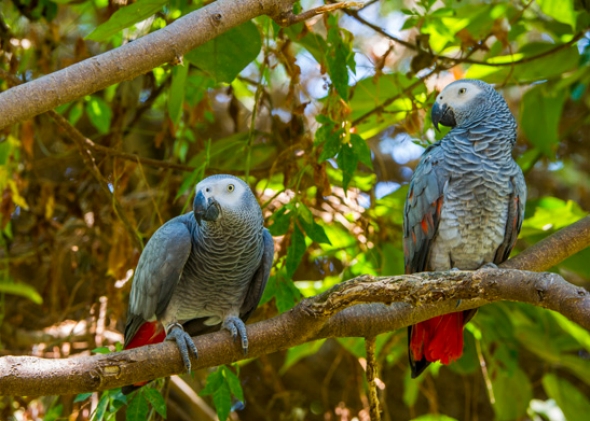Conservationists Cause Extinction
by Aya Katz
Extinction is forever. That’s what they say, and, barring a Jurassic Park scenario, it’s actually true. Most animal lovers are concerned about the endangered species in this world. None of us want to lose the diverse flora and fauna that make up life on this planet. But did you know that with their statist, interventionist policies, many groups purporting to serve conservationist agendas are actually causing the extinction of more and more species?
1. Trade Bans Create a More Demanding and Dangerous Market
The Convention on International Trade in Endangered Species of Wild Flora and Fauna (CITES) is a multilateral treaty intended to protect endangered plants and animals. All member states to the United Nations are signatories to the treaty, but the treaty itself covers trade with nations that have not signed it. In this way, the richest and most powerful nations in the world are able to bully less powerful and connected countries, many of which depend on trade to survive. As with all such schemes involving central planning, there are tragic unintended consequences.
According to Ivo Vegter, a South African author and columnist who writes from the perspective of individual liberty and free markets, many of the policies enacted under CITES actively undermine conservation in Africa. This is partly a result of ignorance in the first world about third world problems and partly due to deliberately misleading propaganda by animal rights activists. For instance, in countries like Namibia and Zimbabwe where conservation of elephants is well managed and some culling is required due to overpopulation, African states that have failed to protect their own elephants are now running roughshod over the ivory trade.
As an example of misleading propaganda, Vegter cites Bagheera, an educational website created by Microsoft’s co-founder Paul Allen, which lumps together both Indian and African elephants and declares them all endangered. In fact, African elephants are not endangered at all. Even within Africa itself, not all elephant populations are facing the same problems, and centralized rules affecting all elephants regardless of where they are located is forcing mismanagement. Ron Thomson, founder of True Green Alliance, expressed incredulity at the new CITES policies:
“How will adding unneeded and unwanted extra protection of southern Africa’s elephant populations help those that are in decline in west Africa? This is not how wildlife management works. Each population has to be managed according to its own merits. And if CITES insists on not allowing southern Africa’s totally safe elephant populations to be managed according to their respective merits, then CITES is forcing the states of southern Africa to mismanage their elephants.”
A similar situation is afflicting the trade in African Grey Parrots. African Greys are native to equatorial Africa and are very popular worldwide for their longevity, intelligence and ability to mimic human speech. They make excellent pets and are useful in animal language research. Alex the Parrot was an African Grey who expanded scientific knowledge in the field. A new listing on Appendix I will now prohibit all trade in wild African Grey Parrots.
You would think that this listing would not have much effect on the trade in African Greys, because 87.5% of African Grey Parrots exported are bred in captivity. South Africa is the world’s largest exporter, and it has never had a native population of African Greys. But, according to Vegter, the illegal trade in African Greys occurred despite their being listed as endangered in their specific countries of origin under Appendix II since 1981. Vegot writes:
Across Africa, tens of thousands of parrots have been exported in violation of quotas. Thousands have been exported in violation of total export bans. Thousands more had CITES export permits saying they were captive-bred, but came from countries with no known breeding facilities.
Imposing a ban on exports does not diminish exports. Quite to the contrary, it raises the market price of the forbidden item and gives greater incentives to black marketeers to go after the coveted bird. According to Vegter:
By banning or heavily restricting international trade in endangered species, CITES has not saved these species. All it achieved in the last few decades has been to drive illegal trade in flora and fauna up the charts to rival the black markets in drugs, counterfeit money, weapons and humans.
Making something illegal to sell does not make selling it happen less often. It just makes the trade in the forbidden item more lucrative to smugglers.
2. Not allowing Sales of Endangered Animals Reduces Breeding
Even when a scheme to reduce sales of wild caught animals is successful, when the sale of domestic-bred specimens of the same species is also banned, then respectable breeders lose their incentive to keep breeding. The result is fewer living specimens of the endangered species worldwide.
Last year, with the declaration of American domesticated chimpanzees an endangered species by U.S. Fish and Wildlife, what was once a thriving trade in domestically bred chimpanzees in the State of Missouri has come to a dramatic end.
While American tax dollars are being siphoned into Africa to help Jane Goodall with her conservation efforts, the government of the United States has effectively banned the sale of domestically bred chimpanzees across state lines. That means that there is no more financial incentive to breed chimpanzees in captivity in the United States, and in all likelihood by the time chimpanzees become extinct in Africa, due to destruction of their habitat, the chimpanzees in the United States will have long since died out. By declaring the American bred chimpanzee — which was never a native wildlife species here — to be endangered, US Fish & Wildlife has guaranteed their extinction.
3. Bans on Travel within the United States for Endangered Animals Keeps Mating from Happening
Sometimes private owners of domesticated animals of an endangered species want to allow their own animal to breed for social reasons of better life satisfaction and not in order to sell the offspring. But when individual specimens live in different states, and the government does not allow them to travel, they can never meet to breed.
Bow, a fourteen year old literate male chimpanzee who lives in Missouri, has his eye on an attractive female chimp who lives in Florida. He has seen videos of her on Youtube, and he would like to get to know her better. Sadly, due to the ban on travel, even if their owners could come to some kind of agreement about a date for the two, unless US Fish & Wildlife approve, they will never meet face to face.
Creating a protected status for animals dooms that animal in more ways than one. Because American wild mustangs are now protected, they can no longer be sold. Because there is no market for them and there is no way to make a profit on their sale, many mustangs are starving to death. Charities try to help but often fail.
Environmentalists are blaming this on “greedy ranchers”, but actually it is an attempt by the Bureau of Land Management to preserve the protected wild status of the mustangs that is dooming them. The irony is that horses, like chimpanzees, are not native to the North America. They were brought here by European settlers, and some escaped. They are not native wildlife. They are just feral.
4. Herding Animals Into Sanctuaries Where They Can’t Breed Leads to Extinction
In the case of many endangered species, once they are herded into sanctuaries for their own good, they are never allowed to breed. Chimpanzees are an example. Sanctuaries claim that there is “surplus” of chimpanzees in the United States and that their purpose is to provide a place for the chimpanzees to live until they die. At these sanctuaries, the chimpanzee must not be allowed to breed. This is in fact codified into law at 42 U.S.C.A. § 283m:
(2) Chimpanzees accepted into system
With respect to chimpanzees that are accepted into the sanctuary system, standards under paragraph (1) shall include the following:
(A) A prohibition that the chimpanzees may not be used for research, except as authorized under paragraph (3).
(B) Provisions regarding the housing of the chimpanzees.
(C) Provisions regarding the behavioral well-being of the chimpanzees.
(D) A requirement that the chimpanzees be cared for in accordance with the Animal Welfare Act [7 U.S.C.A. § 2131 et seq.].
(E) A requirement that the chimpanzees be prevented from breeding.
(F) A requirement that complete histories be maintained on the health and use in research of the chimpanzees.
(G) A requirement that the chimpanzees be monitored for the purpose of promptly detecting the presence in the chimpanzees of any condition that may be a threat to the public health or the health of other chimpanzees.
(H) A requirement that chimpanzees posing such a threat be contained in accordance with applicable recommendations of the Director of the Centers for Disease Control and Prevention.
(I) A prohibition that none of the chimpanzees may be subjected to euthanasia, except as in the best interests of the chimpanzee involved, as determined by the system and an attending veterinarian.
(J) A prohibition that the chimpanzees may not be discharged from the system.
(K) A provision that the Secretary may, in the discretion of the Secretary, accept into the system chimpanzees that are not surplus chimpanzees.
(L) Such additional standards as the Secretary determines to be appropriate.
If chimpanzees are not allowed to breed at the sanctuaries, and if more and more American chimpanzees are funneled into the sanctuary system, then clearly sanctuaries are intended to lead to the extinction of chimpanzees in America.
5. United States Fish & Wildlife Plays Crony Capitalism with Chimpanzees
Presumably, the declaration by US Fish & Wildlife that American chimpanzees constitute an endangered species would at least prevent exporting American chimpanzees to other countries, as that is usually what it means when an animal is declared an endangered species elsewhere in the world. If African Grey parrots are endangered, then you cannot export them from Africa. But that is apparently not how it works for US Fish & Wildlife and American chimpanzees. Their ruling that American chimpanzees are endangered allows US Fish & Wildlife to issue permits to whomever they choose so that some American chimpanzees — but not others — can be sold abroad for commercial purposes.
BOSTON, April 25, 2016 — Today the New England Anti-Vivisection Society (NEAVS) and a coalition of sanctuaries and chimpanzee experts, filed suit against the U.S. Fish & Wildlife Service (FWS) in response to its Thursday (April 21) decision to grant Yerkes National Primate Research Center (Yerkes) a permit to export eight endangered chimpanzees (Yerkes’ 8) — Abby, Agatha, Elvira, Faye, Fritz, Lucas, Tara and Georgia — to Wingham Wildlife Park (Wingham), an unaccredited commercial zoo in Kent, England. Source: NEAVS.ORG
Many in the conservation racket had touted the ruling that American chimpanzees are endangered as a victory for the conservation of American chimpanzees. But apparently, if the right palms are greased, then American chimpanzees can become British subjects — or the property of British subjects — with the proper permits signed in triplicate.

